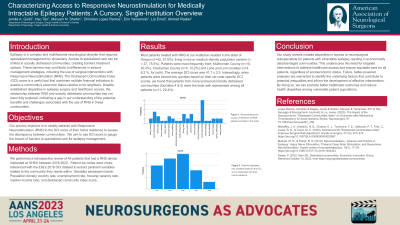Characterizing Access to Responsive Neurostimulation for Medically Intractable Epilepsy Patients: A Cursory, Single-Institution Overview
Characterizing Access to Responsive Neurostimulation for Medically Intractable Epilepsy Patients: A Cursory, Single-institution Overview
Friday, April 21, 2023


Jamila Godil (she/her/hers)
Medical Student
Oregon Health & Science University
Portland, Oregon, United States
ePoster Presenter(s)
Introduction: The etiology of epilepsy is multi-factorial, with genetic and environmental factors influencing its onset and progression. Lack of access to subspecialists can further exacerbate the disease process. The Distressed Communities Index (DCI) score is a measure that combines seven economic indicators into a single value, which is used to convey a community's economic status relative to its neighbors. Our primary objective is to stratify patients with Responsive Neurostimulation (RNS) to the DCI score of their home residence to assess the discrepancy between communities.
Methods: We performed a retrospective review of 49 patients that had a RNS device implanted at OHSU between 2016-2022. Patient zip codes were cross-referenced with the EIG’s 2016 DCI dataset to extract pertinent variables related to the community they reside within. Variables included population density, poverty rate, unemployment rate, housing vacancy rate, median income ratio, and distressed community index score. Descriptive statistics for our analytic sample were performed using SPSS 27.0.
Results: The majority of patients treated with RNS at our institution resided in the state of Oregon (n=42, 91.8%), living in low or medium-density population centers (n = 37, 75.5%). Patients were most frequently from Multnomah County (n=10, 20.4%), followed by Clackamas County (n=5, 10.2%), and both Lane and Linn counties (n=4, 8.2 %, for both). The average DCI score was 41.7 ± 3.3. Interestingly, when we binned patients in quintiles based on their zip code specific DCI scores, we found that patients from more socioeconomically distressed communities (Quintiles 4 & 5) were the least well represented among all patients (n=11, 22.4%).
Conclusion : Our findings suggest disparities in neurosurgical subspecialist access for intractable epilepsy patients across different economically disadvantaged communities. Future, better-powered analyses are needed to identify factors that contribute to potential inequalities in access.
Methods: We performed a retrospective review of 49 patients that had a RNS device implanted at OHSU between 2016-2022. Patient zip codes were cross-referenced with the EIG’s 2016 DCI dataset to extract pertinent variables related to the community they reside within. Variables included population density, poverty rate, unemployment rate, housing vacancy rate, median income ratio, and distressed community index score. Descriptive statistics for our analytic sample were performed using SPSS 27.0.
Results: The majority of patients treated with RNS at our institution resided in the state of Oregon (n=42, 91.8%), living in low or medium-density population centers (n = 37, 75.5%). Patients were most frequently from Multnomah County (n=10, 20.4%), followed by Clackamas County (n=5, 10.2%), and both Lane and Linn counties (n=4, 8.2 %, for both). The average DCI score was 41.7 ± 3.3. Interestingly, when we binned patients in quintiles based on their zip code specific DCI scores, we found that patients from more socioeconomically distressed communities (Quintiles 4 & 5) were the least well represented among all patients (n=11, 22.4%).
Conclusion : Our findings suggest disparities in neurosurgical subspecialist access for intractable epilepsy patients across different economically disadvantaged communities. Future, better-powered analyses are needed to identify factors that contribute to potential inequalities in access.
